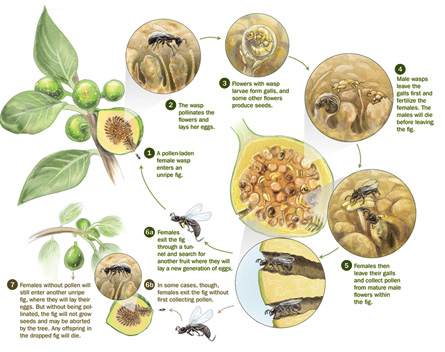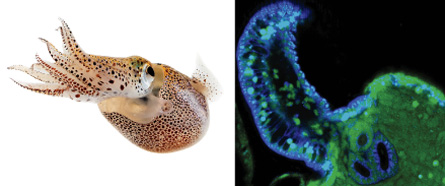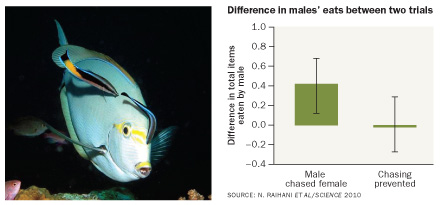Nature’s recourse
How plants and animals fight back when deals go sour
Nature has a shifty side. Bees cheat flowers. Flowers cheat bees. Fish cheat other fish, and so on. The more biologists look, the more skulduggery turns up.






In this sense, cheating means pretty much what it does among people, says evolutionary biologist Toby Kiers of VU University Amsterdam: One party exploits another, taking more than its fair share or happily reaping benefits without paying the costs. “There is always that one person that orders the most expensive meal on the menu and then insists on splitting the bill evenly,” Kiers says.
Diners in nature don’t always mind their manners, either. A bee that bites through a flower wall for a long, sweet drink of nectar but doesn’t reciprocate by moving pollen, for instance, has cheated the plant. Such nectar snatches violate an evolutionarily ancient arrangement of trading food for pollination.
No outraged tablemates crack down on freeloaders in the wild. Yet, Kiers says, “Nature has its own tools.” These safeguards help keep pollinators pollinating and many other vital, two-partner biological processes humming along.
Theorists have long predicted that such anti-exploitation measures would have evolved. Now a burst of studies are revealing how real organisms cope with cheating. Most dramatic are the lethal punishments enacted by otherwise harmless-looking partners. “Plants can be brutal,” Kiers notes. Other creatures deliver sanctions that aren’t so harsh, or instead switch partners when things don’t work out. And in some cases of natural larceny, the cheating amounts to an annoyance that is easier to live with than to fight.
Odd couples
Species trade benefits all the time. Biologists have estimated that virtually every species on the planet participates in some win-win exchange, dubbed a mutualism, says Judith Bronstein of the University of Arizona in Tucson. And these mutualisms make life work.
Most organisms on Earth can’t get the nitrogen they need from the atmosphere. Instead many rely on the partnership between legume plants and bacteria that live in root nodules and create user-friendly nitrogen. And more than 80 percent of land plant species get extra phosphorus from the soil via fungi that also mingle their way into root tissues, getting sugar in the process.
Animals, including magazine readers, get nutrition assistance from gut-dwelling microbes with enhanced digestive powers. And many flowering plants, including three-fourths of leading food crops, need mobile members of the animal kingdom to act as go-betweens for sexual encounters. This flower-pollinator bond alone enhances human endeavors from the florist and landscaping industries to romance, poetry and the bold frontiers of hat design.
There’s a dark side, though. “Point out a mutualism to me, and I can point out a cheater,” Bronstein says.
Cheating looks, at least in some sense, like a winning strategy. Not paying the full cost gives an exploiter more resources to put into making cheater babies. Over generations these freeloaders might expand and take over, destroying the partnership. Yet a lot of mutualisms seem to be doing just fine, thank you. So what effect the cheaters have is an open question.
“The big thing in the last few years has been a wave of support for how sanctions and other enforcement mechanisms can stabilize cooperation,” says Stu West of the University of Oxford in England. Some of the restraints found so far are Wild West straightforward: The cheater gets taken out.
Greedy pollinators
For an Asian tree, a no-nonsense strategy for dealing with cheaters means aborting some flowers, Kiers and colleagues report in the March Ecology Letters.
Goblet-shaped, green female flowers and more flattened male ones burst out in masses on the Glochidion acuminatum tree. The blooms are tiny, though, each flower barely as large as a rice grain, and Kiers says a casual observer can walk by a tree in full bloom without noticing. The pollinator is easy to miss too: a gray moth visiting only at night.
Science as a whole had missed this mutualism until a 2003 study by Makoto Kato of Kyoto University, who was a coauthor on the Ecology Letters paper. With extreme patience, Kato’s team discovered that female Epicephala moths transfer pollen from the male flowers to the female ones. Moths benefit by injecting eggs into the safe, nurturing innards of the female flower. Having an egg injected into a maturing flower reduces the number of seeds the flower can produce, but the attention from moths must be worth it, at least up to a point.
To explore the dynamics of the newfound mutualism, Kiers joined Japanese colleagues camping among World War II bunkers on Japan’s Amami-Ohshima Island. Sitting in the dark waiting for a gray moth might not thrill everyone, Kiers says, “but for a scientist studying mutualisms, spotting the moth is like seeing a Siberian tiger in the wild.”
The Glochidion trees shed a lot of their flowers before they mature into fruits, and Kiers and her colleagues analyzed the number of moth eggs found in the aborted flowers. Those cradling one egg weren’t more likely than egg-free flowers to hit the ground, but blooms with two or three moth eggs grew progressively more likely to be dropped.
Since flower drop dooms any moth developing inside, the trees seem to be punishing moths that fail to search out untouched flowers and thus impose too much of a burden, Kiers and her colleagues propose.
This scenario echoes the smackdown that yucca plants can give unsatisfactory moths. Described in 1994, this response was the first clear-cut case of punishment in a mutualism. Yuccas depend on specialized moths for pollen delivery and offer those moths floral cradles. And yuccas tend to abort flowers that get overburdened with eggs (like the Asian trees) or that are neglected by pollinators, according to Olle Pellmyr, now at the University of Idaho in Moscow, and his colleagues. Although not closely related botanically, the Asian trees and the yuccas face similar risks in their mutualisms and have converged on similar punishments.
In fig trees, lethal punishments appear worthwhile. Pollinators of more punitive fig species seem to be better behaved than pollinators partnering with laxer figs, says Allen Herre of the Smithsonian Tropical Research Institute’s station on Barro Colorado Island in Panama.
Like yuccas and the Asian trees, figs trade infant protection for pollen delivery. Each of the more than 700 known fig species partners with just a few species of tiny, highly specialized wasps. The female wasps wriggle into closed pouches holding the trees’ flowers and lay eggs there. The figs face the usual downside of these day-care deals: Raising baby pollinators means the plants produce fewer seeds of their own.
Herre’s colleague, Charlotte Jandér, now at Cornell University, collected several thousand fig wasps near the Panama Canal and checked them for pollen. In four fig species, wasps preparing to leave their childhood home usually rummage through the flowers and pack pollen to go. But on occasion, from about 0.3 percent to 5 percent of the time, depending on species, the wasps shirk the task and fail to deliver pollen, Jandér and Herre report in the May 22 issue of Proceedings of the Royal Society B.
They also assessed the ferocity of the partner trees’ punishments by coaxing pollen-free wasps into the flower pouches to see what happened. Tree species varied in how readily they aborted fruit (and thus killed the young wasps) when the insects didn’t live up to their duties. For fig species that slammed nonpollinator wasps with tough punishments, “you find very assiduous, meticulous, hardworking wasps,” Herre says. For laxer fig species, “that’s where you find more lazy, cheater, ne’er-do-well wasps.”
Fig trees are no angels either. Herre points out that almost half the known fig species have evolved a pollination system that abuses partner wasps by luring them into specialized female-only flower pouches that accept pollen but kill the wasps’ young. Herre says wasps don’t yet seem to have evolved a way to punish the plants.
Tough beans
Beans don’t go so far as to sacrifice their own flowers to punish a cheater — still, a legume is not be trifled with.
From soybeans to sweet peas to flamboyant tropical trees, the world’s legumes negotiate intricate mutualisms with nitrogen-fixing bacteria. Recruited from the soil, rhizobial bacteria reside in custom-built nubbins of root tissue where the plant feeds them carbohydrates. Once in the new quarters, bacteria start using their unusual enzymes to crack the strong bonds of paired nitrogen atoms, thus supplying the plant with nitrogen in the more usable form of ammonia.
To see what a plant might do to slacker bacteria that don’t pay their rent, Kiers and her colleagues forced the bacteria to cheat on command. Using air-tight containment areas, the researchers isolated individual root nodules of a single plant inside their own atmospheres. When Kiers filled a nodule’s zone with a largely argon atmosphere, the bacteria in the nodule couldn’t get atmospheric nitrogen as a raw material. It wasn’t their fault, but they failed in their obligations.
The plants retaliated by changing nodule permeability, cutting back on the bacteria’s oxygen supplies. The sudden oxygen reduction halved the rhizobial bacteria’s usual rate of reproduction.
Cheating rhizobia, known in agriculture, have now been found in the wild.
Joel L. Sachs of the University of California, Riverside and his colleagues collected and analyzed root bacteria from four Lotus legumes growing in Bodega Marine Reserve and Sonoma Coast State Park. One rhizobial strain the team collected, belonging to the nitrogen-fixing genus Bradyrhizobium, proved to be a miscreant that induced lab plants to grow nodules but then just sat inside providing nothing in exchange. In lab tests, the freeloading strain reproduced more abundantly than the dutiful strains, Sachs and his colleagues report in the May Journal of Evolutionary Biology. Lotus in the wild might find it handy to dial down oxygen on goof-offs.
Outright punishments aren’t the only choice for coping with scam artists, though. Some mutualists appear to reward good behavior, an approach James Bever of Indiana University in Bloomington calls preferential allocation.
Spare the rod
Bever works with a large group of fungi called arbuscular mycorrhizae. When these fungi encounter a plant root of a species they can work with, they poke through the outer wall of root cells and branch into treelike tangles. The tangles press against the inner cell membrane, which bulges around them. “It’s like sticking your hand into a balloon,” Bever says. The fungi feed on plant carbohydrates and pass along phosphorus from the soil.
In lab tests of wild garlic plants with roots divided in two parts, roots partnered with more productive fungi carried extra carbohydrates to the star performers. The other root bunch, forced to associate with a less productive fungal strain, carried less, thus shorting the slackers, Bever’s team reported in 2009. What actually happens in real soil is the next big question.
Bever doesn’t classify this as punishment, though, because the fungi don’t appear to suffer much. They can draw the needed nutrients from other plant partners or survive on their own. “If you don’t give a child a lollipop, is that punishment?” he asks. He doesn’t think so. Of course, the child might disagree.
Large reef fish that rely on smaller ones for grooming use a mix of mild punishments and tools of the marketplace to get good service. On reefs, big fish itchy with parasites swim to spots frequented by small specialist cleaner fish. As the bigger fish hovers, the cleaners work the client over, nipping off the parasites.
Experiments offering cleaner fish a choice of snacks have established that the cleaners will eat the parasites but prefer the clients’ protective mucus coating. Should a cleaner cheatand nip off a bit of mucus, though, the client darts after the small fish in a snapping, menacing chase.
After all the plant violence, a mere chase may not seem like much of a threat, but clients often have another recourse: They can take their business elsewhere. And a paper in the January 8 Science found that cleaners themselves occasionally get upset. The team argues that males will chase a female cocleaner at a family-run station if she nips a client’s mucus, thus threatening mutual interests by scaring away business.
Meanwhile, bobtail squid swimming around the Hawaiian Islands may follow the same advice that fretting mothers deliver to teens: Be careful in screening partners before intimate involvement.
The squid Euprymna scolopes hunts at night and allows luminous strains of Vibrio fischeri bacteria to colonize an organ in its body cavity, creating an internal night-light. With bacteria at work, the soft glow disguises the squid’s silhouette from creatures swimming below. To move in, however, a bacterium needs to respond just right to chemical signals from the squid. “A series of locks and keys” is how Margaret McFall-Ngai of the University of Wisconsin–Madison describes the back-and-forth of biochemical interactions. In 2009 a team of researchers identified a gene form that is found in the strains of light-producing bacteria that colonize squid but not in strains that colonize fish.
If a lackluster strain does make it in, the squid have a back-up punishment plan, McFall-Ngai notes. They deny the bacteria sustenance.
Just deal with it
Some mutualists may not punish or goad substandard partners at all, treating them just as a nuisance to live with. Consider that flower that gets drained of nectar by a bee that doesn’t pollinate. “A bunch of flowers get damaged — oops! You make more,” says ecologist Rebecca E. Irwin of Dartmouth College in Hanover, N.H.
So far, scientists haven’t found clear-cut evidence of punishment for potential pollinators that grab the nectar and run. That’s true even though species such as the flower Irwin studies, the scarlet gilia, produce fewer seeds after burglaries. This situation suggests that the cheaters aren’t destroying the partnership.
Bronstein also has studied plant-pollinator mutualisms and says they have left her cautious about automatically treating cheaters as horrible menaces that demand a response. In the jimsonweed that she studies, hawkmoths deliver pollen in exchange for nectar, but also lay eggs on the plants. If given the chance, larvae will quickly gnaw the plants’ leaves down to nubs.
Instead of preventing caterpillar gorging, the plant seems to excel in recovering from damage. New leaves sprout quickly, and life goes on for the jimsonweed.
Though new research has uncovered cases where cheaters pay heavy tolls, Bronstein says she would like to know how widespread those outcomes are. A new generation of models suggest that it is not hard to come up with conditions that allow cheater species to persist without annihilating the mutualism.
“The idea that cheaters are incredibly costly is too general an idea,” she says. Maybe the threat of cheating to the future of mutualisms is just exaggerated.
Cheaters would still have an effect, Bronstein says. They might change the evolutionary path of their teammates, but they might not end the partnership. Among critters, as among people, then, unfair behavior may amount to an annoying, persistent part of life.